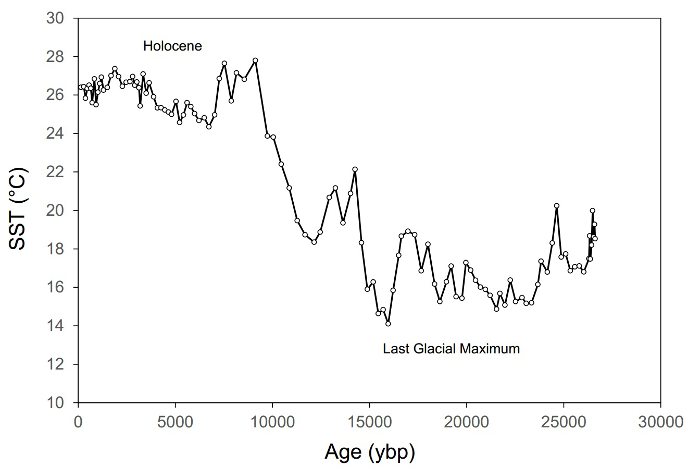Extraction of Biomarkers from Sediments - Accelerated Solvent Extraction
Source: Laboratory of Jeff Salacup - University of Massachusetts Amherst
The distribution of a group of organic biomarkers called glycerol-dialkyl glycerol-tetraethers (GDGTs), produced by a suite of archaea and bacteria, were found in modern sediments to change in a predictable manner in response to air or water temperature1,2. Therefore, the distribution of these biomarkers in a sequence of sediments of known age can be used to reconstruct the evolution of air and/or water temperature on decadal to millennial timescales (Figure 1). The production of long high-resolution records of past climates, called paleoclimatology, depends on the rapid analysis of hundreds, possibly thousands of samples. Older extraction techniques, such as sonication or Soxhlet, are too slow. However, the newer Accelerated Solvent Extraction technique was designed with efficiency in mind.

Figure 1. An example of a paleoclimate record showing changes in sea surface temperature (SST) in the eastern Mediterranean Sea during the past ~27,000 years3. This record comprises ~115 samples and is based on the isoprenoidal GDGT-based TEX86 SST proxy.
1. Collection of the Necessary Materials
- Extract samples. Samples (in this case, sediment) are frozen, freeze-dried, crushed, and homogenized prior to extraction, and extracted in groups to maximize efficiency.
- Depending on the size of the sample, use collection vials with volumes of 40 or 60 mL. For this experiment, borosilicate glass vials (40 mL) and solvent safe caps are used. Combust vials, borosilicate glass pipettes, and weighing tins at 550 °C for 6 h prior to ensure removal of possible
At the end of the extraction, there is a total lipid extract (TLE) for each sample. Each vial now contains the extractable organic matter from a sediment, soil, or plant tissue. These TLEs can be analyzed, and their chemical constituents identified and quantified.
The TLEs of the extracted samples contain a wide spectrum of different organic compounds, including the GDGTs to be used to reconstruct ancient temperatures. Glycerol-dialkyl glycerol-tetraethers are a large suite of biomarkers that show sensitivity to growth temperatures. There are two groups of GDGTs, branched and isoprenoid, which differ in the character of the branching patterns on the core alkyl groups (Figure 3). In the ocean, a cosmopolitan group of archaea, called Thaumarchaeota,
- Schouten, S. et al. Distributional variations in marine crenarchaeotal membrane lipids: a new tool for reconstructing ancient sea water temperatures?, Earth and Planetary Science Letters, 204(1-2), 265-274 (2002).
- Weijers, J. W. H. et al. Environmental controls on bacterial tetraether membrane lipid distribution in soils, Geochimica et Cosmochimica Acta, 71(3), 703-713 (2007).
- Castaneda, I. S. et al. Millennial-scale sea surface temperature changes in the eastern Mediterranean (Nile River Delta region) over the last 27,000 years, Paleoceanography, 25, 13 (2010).
- Damste, J. S. S. et al. Crenarchaeol: the characteristic core glycerol dibiphytanyl glycerol tetraether membrane lipid of cosmopolitan pelagic crenarchaeota, J Lipid Res, 43(10), 1641-1651 (2002).
- Hopmans, E. C. et al. A novel proxy for terrestrial organic matter in sediments based on branched and isoprenoid tetraether lipids, Earth and Planetary Science Letters, 224(1-2), 107-116 (2004).
- Tierney, J. E., Russell J. M. Distributions of branched GDGTs in a tropical lake system: Implications for lacustrine application of the MBT/CBT paleoproxy, Organic Geochemistry, 40(9), 1032-1036 (2009).
- Damste, J. S. S. et al. 13,16-Dimethyl Octacosanedioic Acid (iso-Diabolic Acid), a Common Membrane-Spanning Lipid of Acidobacteria Subdivisions 1 and 3, Appl Environ Microb, 77(12), 4147-4154 (2011).
Vai a...
Video da questa raccolta:

Now Playing
Extraction of Biomarkers from Sediments - Accelerated Solvent Extraction
Earth Science
8.9K Visualizzazioni

Determining Spatial Orientation of Rock Layers with the Brunton Compass
Earth Science
25.5K Visualizzazioni

Using Topographic Maps to Generate Topographic Profiles
Earth Science
32.0K Visualizzazioni

Making a Geologic Cross Section
Earth Science
47.0K Visualizzazioni

Physical Properties Of Minerals I: Crystals and Cleavage
Earth Science
51.6K Visualizzazioni

Physical Properties Of Minerals II: Polymineralic Analysis
Earth Science
38.0K Visualizzazioni

Igneous Volcanic Rock
Earth Science
39.7K Visualizzazioni

Igneous Intrusive Rock
Earth Science
32.3K Visualizzazioni

An Overview of bGDGT Biomarker Analysis for Paleoclimatology
Earth Science
5.4K Visualizzazioni

An Overview of Alkenone Biomarker Analysis for Paleothermometry
Earth Science
7.2K Visualizzazioni

Sonication Extraction of Lipid Biomarkers from Sediment
Earth Science
8.8K Visualizzazioni

Soxhlet Extraction of Lipid Biomarkers from Sediment
Earth Science
18.5K Visualizzazioni

Conversion of Fatty Acid Methyl Esters by Saponification for Uk'37 Paleothermometry
Earth Science
10.1K Visualizzazioni

Purification of a Total Lipid Extract with Column Chromatography
Earth Science
12.4K Visualizzazioni

Removal of Branched and Cyclic Compounds by Urea Adduction for Uk'37 Paleothermometry
Earth Science
6.4K Visualizzazioni